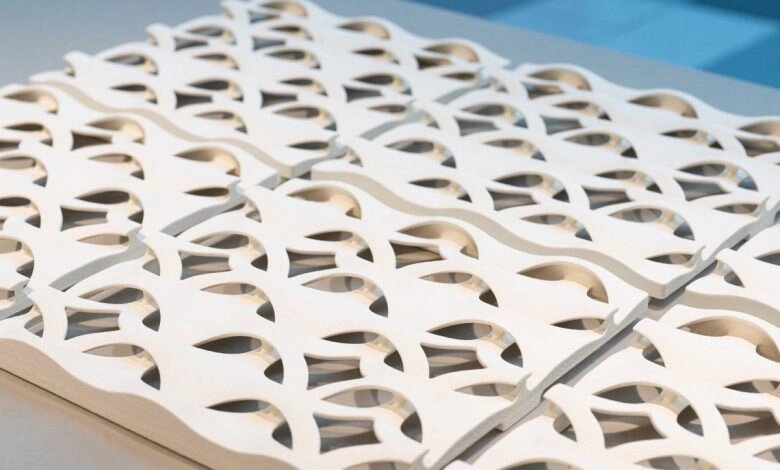Specifically designed on the VX1000 for investment casting shells and cores
In a joint tailoring project, Japanese ceramics expert AGC Ceramics Co., Ltd (AGCC) and voxeljet AG have qualified the high-performance ceramic material Brightorb for 3D printing. In addition to potential applications in the production of structural components and works of art, the material is particularly suitable for 3D printing of highly complex molds and cores for metal casting.
Brightorb was developed on a VX1000 with a build volume of 1000 x 600 x 500 mm. The 3D printing system works layer-based and bonds the ceramic particles with an inorganic binder. Targeted applications for the new, ceramic material set include high-performance cores for sand and investment casting, ceramic filters, structural components, as well as art and product design.

In close cooperation, the VX1000 3D printer was tailored specifically to the specifications of Brightorb by AGCC and voxeljet
The ceramics material with its brand name Brightorb is composed of spherical sand with the main components Aluminum Oxide (Al2O3) 80%, Zirconium Oxide (ZrO2) 10%, Silicon Oxide (SiO2) 9%, the minerals Corundum, Baddeleyite and kinds of cement. During 3D printing, Brightorb is applied to the build platform with average grain sizes of 50 μm and layer thicknesses of 100 μm and selectively bonded with an inorganic binder.
The inorganic binder is characterized by its high environmental compatibility as only water vapor is produced during molding. This greatly improves environmental and working conditions in foundries. To subsequently prepare the printed ceramic for the final application, the printed components get impregnated by a silica-based liquid and have to be fired in a sintering furnace for their final strength. Most of the unprinted powder can be reprocessed, recycled and fed back into the printing process.

Investment casting cores 3D printed with Brightorb offer unique advantages in terms of chemical stability, heat resistance, thermal conductivity and low thermal expansion
“We have been noticing a growing demand for increasingly complex component geometries among our customers for a long time,” explained Dr. Ingo Ederer, CEO at voxeljet. “The great advantage of the geometric freedom of 3D printing is, that geometric adjustments can significantly optimize the efficiency and effectiveness of, for example, engines or turbine wheels. It is rare that such complex components can still be produced using conventional molding processes. Together with AGCC, we have been able to optimize a VX1000 for ceramic powder in close cooperation, so that it is ideally suited for the challenging demands of metal casting. Both in terms of strength and surface quality”, said Dr. Ederer.

Besides technical applications, Brightorb can also be used for design elements such as tiles or other decorative elements and goods.
The 3D printed ceramics are used, for example, as cores for the investment casting process in order to reproduce complex and filigree cavities within castings. In this process, the filigree cores are combined with conventional wax patterns. These are coated with a ceramic slurry and burned out before casting. What remains is a hollow ceramic mold in which the printed core is still inserted. Molten metal is then poured into the mold. After cooling, both the mold and the core are removed.
This process makes it possible, for example, to integrate internal cooling channels in turbine blades, thus increasing turbine efficiency and reducing downtimes to a minimum.

Brightorb can also be used to create three-dimensional ceramic Art based on 3D designs
Mr. Ushimaru, Additive Manufacturing Director from AGCC is also satisfied: “Brightorb is a high-performance ceramic that is extremely well suited for metal casting due to its high-chemical stability, heat resistance, thermal conductivity and low thermal expansion. We were able to optimize the material set in such a way that the shrinkage factor of the printed components during the downstream sintering process at 1,400°C is less than 1%. This means that the components are also suitable for filigree core designs. Thanks to the high-fire resistance, it is possible to cast alloys with melting points beyond 1,600°C. Overall, ceramics will continue to gain importance as a material in the future, and the same applies to 3D printing as a manufacturing technology. We are pleased to have embarked on this path together with voxeljet and look forward to further close cooperation.”
Brightorb was qualified in voxeljet’s Material Certification Lab in Friedberg, Bavaria, Germany. The powder was developed by AGCC and adapted to 3D printing together with voxeljet. Commercial availability of the Brightorb is scheduled for July 2021 onwards, both for printing systems and as an on-demand service.

Source: https://www.3dprintingmedia.network/agc-ceramics-and-voxeljet-develop-new-brightorb-ceramics-for-3d-printing/
